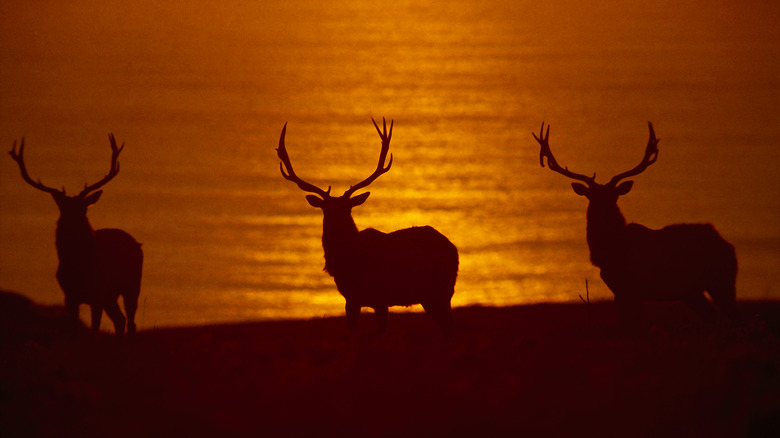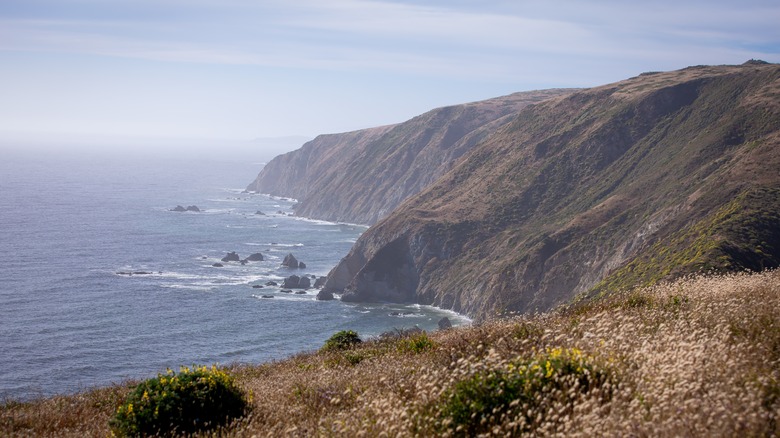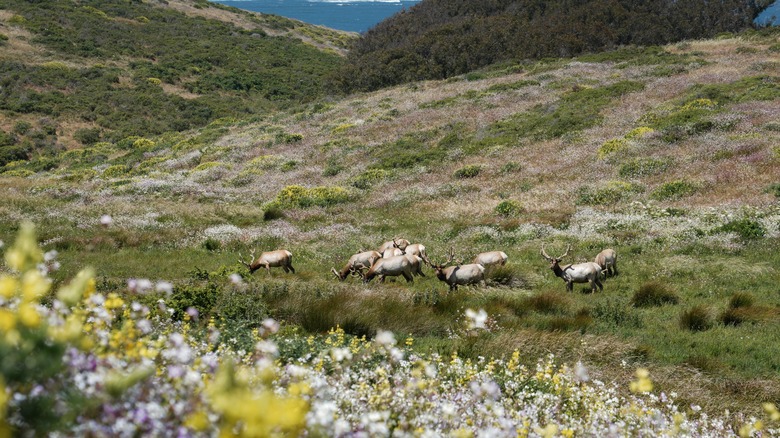You're Almost Guaranteed An Elk Sighting On This Spectacular Coastal Trail In California
As you're exploring California's striking coastline via an epic road trip, you'll want to make a stop at Point Reyes National Seashore, just about 60 miles north of San Francisco. It's a must-visit for any wildlife lovers and those who always pack hiking gear on vacation. It's home to a herd of tule elk, and hiking the Tomales Point Trail gives you a good chance of seeing them. You don't even have to hike the whole 9.5-mile trail to see these majestic creatures — just a mile in, and you're likely to catch a glimpse. Along with some one-of-a-kind wildlife spotting that you might expect at a national park, you'll get to see some incredible views of the Pacific Ocean along windswept headlands.
Here's a bit more about tule elk and why getting a chance to see them is so special. They're the smallest elk subspecies in North America, and they can only be found in California. They used to live throughout much of Central and Northern California, numbering, by some estimates, into the hundreds of thousands. An invaluable part of the ecosystem, these elk helped shape the development of a variety of native California plants over time. They got their name (pronounced too-lee) from a marsh grass they liked eating and using for shelter. With European settlement, tule elk numbers dwindled to the point that, by the 1870s, they were thought to be extinct. However, Henry Miller, a local rancher, discovered a small herd, including one breeding pair on his land, and worked to preserve them. From that small number, and thanks to years of dedicated conservation work, there are now around 5,700 tule elk in California.
Tomales Point Trail at Point Reyes takes you through the elk reserve
In 1978, 17 elk were brought from a wildlife refuge near Los Banos to Point Reyes National Seashore. The population has thrived, and as of 2023, 300 of them can be found here. They're on a fenced-in reserve of nearly 3,000 acres within the 77,000 acre park, concentrated around Tomales Point, the northernmost portion of the Point Reyes National Seashore peninsula.
The out-and-back Tomales Point Trail takes you into their territory. It starts next to Pierce Ranch, where you can learn about the history of ranching in the area. From there, the trail heads northwest along the bluffs. At Windy Gap, about a mile in, you're likely to see tule elk to the east — basically anywhere there's fresh water, you're likely to see elk congregating. If you head northwest, you'll encounter a bit more elevation change, but if you keep going for a couple more miles past Windy Gap, and you'll get to a pond. You'll most likely see more elk here, too.
This could be a good place to turn back and still get a solid hike in — it'll be about 6 miles total. But if you want to keep going, it's approximately 1.5 miles more to the end of the trail. Be aware that this last section isn't maintained, and it gets sandy, hard to follow, and a challenge to slog through at times.
Things to be aware of on the Tomales Point Trail
If you hike the Tomales Point Trail between August and October, you may get the chance to hear male elk bugling during the rut. It's a way for the males to attract females and show dominance to other males during mating season. This is also a time when you need to be extra mindful of where you are in relation to these animals. There are no fences separating you from the elk along the trail, but keep a respectful distance from them, and you shouldn't have much trouble. Never come between elk, if you can, particularly between mothers and calves or bull elk looking for a fight (assume that between August and October, all the bull elk are looking for a fight). Bring binoculars or a spotting scope to get the best view of these animals from the trail; going off trail and/or getting too close to these wild animals can be dangerous.
The trail is entirely exposed; aka there's no shade. Bring water, sunscreen, and layers. The weather can change and range from warm(ish) — around 70 degrees Fahrenheit — to downright chilly, and it can be sunny, foggy, or both, all within the same hike. While the elk can be dangerous if you get too close to them, the biggest danger along the Tomales Point Trail are the cliff edges. They can be unstable, and even if you're far from the edge, there's poison oak and stinging nettles growing here; for your own comfort and safety, stick to the trail. With those precautions in mind, you're set to enjoy a memorable hike in a stunning setting.


